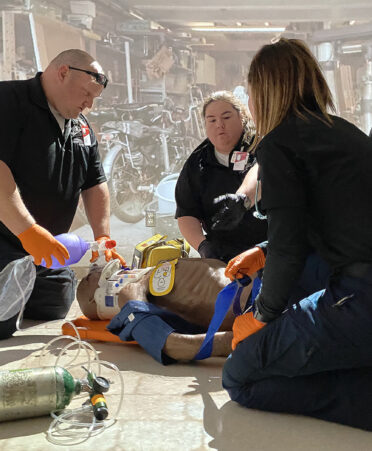(BROWNWOOD, Texas) – The scene: a neighborhood garage. The actor: an unresponsive elderly male. And — action.
Texas State Technical College Paramedic students in Brownwood were not outside a home. They were on campus, in a classroom, with a 360-degree view of the garage. The students were performing their first scenario in TSTC’s newest technology — an Immersive Interactive virtual reality lab.
“They did a great job with this being their first response in the room,” instructor Tim Scalley said. “Now we can provide that extra sensory involvement so they can be more observant.”
The sensory element showed when student Rebecca Mendez noticed a cat going through a pet door on the screen.
“You could have the firefighters show up late to a scene because they were helping that cat get out of a tree,” Scalley told the students during their debriefing session.
Scalley knows that with each passing scenario, his Paramedic and Emergency Medical Services students will show improvement.
“Now that the shock and awe of how we can train is gone, I can only see improvement coming for every student,” he said.
Having the new technology in Brownwood is a big improvement for Robert Rodgers, who completed the EMS program at TSTC 14 years ago.
“I remember when we were doing CPR on a gym floor, pretending it was a wreck scene,” he said. “This is the next step in our training, and I think it will be interesting to see how it goes.”
Misty Lane was the team leader for the scenario. It was her first experience in the lab and as team leader.
“This was definitely a different way of training than when I completed my EMT (emergency medical technician certificate) here,” she said. “It was also weird going from always being the partner to the lead. I know this technology will help improve all aspects of my career.”
Daniel Ortega was a member of the responding team, saying it provided at least one aspect that they did not have before in class.
“This will really teach us more about safety. It is so lifelike being in the scene,” he said. “We will have to notice the little things when we respond.”
One of those little things was noticed by Terry Kolb, the third member of Lane’s team. Kolb noticed a chair on the ground and immediately asked if trauma was part of the scenario.
Scalley, who was monitoring the patient’s condition, responded, “Maybe.”
Kolb immediately said the patient should be placed in a cervical collar.
“Being in the scenario where he can see what is around us is more beneficial,” he said. “Now we have to make sure everything falls into place.”
Mendez and Rodgers played responding firefighters and helped the paramedics. Both were also able to critique their classmates while watching in real time.
“This showed us that we have to make sure nothing hazardous is around,” Mendez said. “In the field, we know to be aware of our surroundings, and now we have that in the classroom.”
Once Lane and her team secured the patient, they transported him to the virtual hospital in the ambulance simulator located in the classroom. After the commute time had elapsed, they wheeled the patient back to the reality lab, where Scalley had a hospital emergency room on the screen.
“This program gives you so many different options. We can provide any scenario for our students to respond to,” Scalley said.
One thing missing from the training is something that Mendez is looking forward to.
“I cannot wait for the scents to come in and to experience it fully,” she said.
Scalley said the technology provides different scents to accompany various scenes.
“Having the scents will make you more aware that you are in the field and not in the classroom,” he said.
The students are looking forward to the next scenario, which they know will be even tougher.
“I cannot wait for the next one. I want to do a scenario on a volcano,” Kolb said, to which Scalley smiled, knowing that scene is available.
The Immersive Interactive lab, which allows instructors to create a diverse range of environments from pre-hospital to the emergency room to prepare students for stressful and demanding real-world situations, is available at TSTC’s Abilene, Brownwood and Harlingen campuses.
For more information about TSTC, visit tstc.edu.
